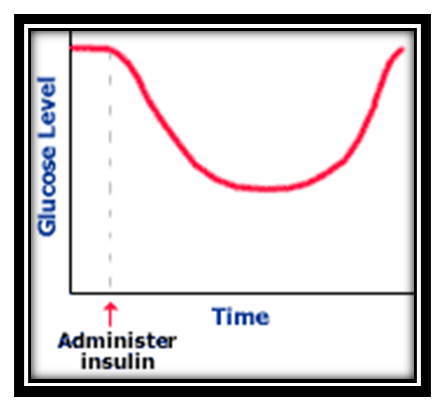Vintek Nutrition Study – Type I Diabetic Dogs – Original 2009 and Update 2014 (2/5/14)
EXECUTIVE SUMMARY:
A multiple-veterinarian study on Canines with Type I Diabetes showed conclusive results. When Dia-Treaties® was supplemented with insulin, all dogs in the study experienced significant decreases in their blood glucose (b/g) levels (see graphs) decreased to the normal range. It was also observed that the dogs required less insulin and had improved glycemic control due to increased insulin sensitivity.*
Many of the Canines in the study were insulin resistant. Because the Dia-Treaties® formula lowered blood glucose levels, this led to a number of other observed benefits such as: healthy skin and coat, decrease in urinary tract Infections and improved overall health and vitality.*
UPDATE:
The initial study on Type I Diabetic Dogs started in 2009. Dia-Treaties® was introduced along with insulin. The original study included 8 dogs of various breeds with multiple veterinarians observing and reporting empirical data. Currently, in 2014 the number of dogs reported is 27 (2 with Cushing’s disease and diabetes) and 19 veterinarians are involved. (See Subjects below).
CRITERIA: Initially, the stud y contained 8 insulin resistant diabetic dogs with at or near maximum insulin requirements being utilized. Insulin amounts were kept steady to objectively evaluate the results of the addition of Dia-Treaties® as the only variable. Dogs were on either Humulin N® or Vetsulin® insulin. Glucose curve readings were taken midday of the 12 hour cycle. At midday, if controlled, the subject should be in the 80 to 120 mg/dl range for normal blood glucose readings.
y contained 8 insulin resistant diabetic dogs with at or near maximum insulin requirements being utilized. Insulin amounts were kept steady to objectively evaluate the results of the addition of Dia-Treaties® as the only variable. Dogs were on either Humulin N® or Vetsulin® insulin. Glucose curve readings were taken midday of the 12 hour cycle. At midday, if controlled, the subject should be in the 80 to 120 mg/dl range for normal blood glucose readings.
OTHER GRAPHS ATTACHED EXPLAINED
Graph# 1 The line graph and illustrates the (b/g) reading prior to the introduction of Dia-Treaties®, the week they started Dia-Treaties®- (0) and the following weeks thereafter for a total of 6 readings. Graphs #2 Dogs (C2 and C3) ran out of the formula 4 days prior to testing and their (b/g) levels spiked. Observing those results, Dia-Treaties® were removed from 4 other dogs previously regulated (C4,5,6,7) to determine if their b/g levels would spike as well. The subjects were quickly returned to the Dia-Treaties® regimen again and resumed to controlled blood sugar levels.
SUMMARY:
Our findings indicate the effectiveness of Dia-Treaties® when introduced into the regimen along with insulin injections. Empirical and subjective data collected indicate that the unregulated dogs were not regulated until Dia-Treaties® were introduced. Once regulated, insulin dosage had to be decreased in the range of 15% to 67%. Based on the observed need to lower insulin levels, we recommend veterinary supervision in addition to a self-monitoring b/g kit while initially testing, due to possible hypoglycemia (low b/g readings). (see below). The subjective results such as: more vitality, skin and coat improvement, etc., indicate all dogs, seemingly regulated or unregulated would benefit from the inclusion of Dia-Treaties® in their diabetic treatment. It was noted that those dogs discontinuing the use of Dia-Treaties® needed to resume their use to maintain glycemic control. For additional observations please see customer testimonials at: http://www.vinteknutrition.com/pages/Testimonials.html
Subjects & Veterinarians: Types of Canines in the study: n=27: Italian Greyhound (2), Miniature Pinscher (2), Cairn Terrier (1), Golden Retriever (1), Schnauzer (2), Welsh Corgi (2), Labrador Retrievers (3), Mixed Breeds (2), Spitz (1), Poodle/Pomeranian (1), Yorkshire Terrier (2), Lab/Bassett Hound (1), Sheepdog (1), American Eskimo (1), Dachshund (1), Chesapeake Bay Retriever (1), Brittany Spaniel (1).
Veterinarians: N=19: Dr. Sam Lukens, Luken’s Animal Clinic – Head Researcher, Sioux Falls, SD. Total of 19 veterinarians/owners reporting from various states: (SD 9, ND 1, CA 2, WA 1, OH 1, OK 1, KY 1, AZ 1, and MN 2).
Dia‐Treaties® Users: Please use under the supervision of a licensed veterinarian. A blood glucose monitoring kit is recommended. Dia‐Treaties® is known to enhance insulin’s uptake and your pet may experience a low blood sugar reading requiring you to lower insulin amounts. The signs of hypoglycemia (low blood sugar) can be as follows: lethargy, loss of balance, trouble walking and confusion to mention a few. One should consult your veterinarian immediately. If you have a diabetic dog, you should have a glucose increasing food (syrup, sugar, etc.) available should you experience a low blood sugar event. Low blood sugar is very dangerous and potentially fatal. Once the optimal insulin dosage along with the proper number of Dia-Treaties® (see box for dosage) has been established, clients experienced the need to decrease insulin dosage in the range of 15% to 67%. In the first 3 Days to 4 Weeks, it is especially important to monitor the blood glucose carefully with your veterinarian and/or a blood glucose meter. Dia‐Treaties® is not a cure for diabetes, however, once the correct amount of insulin and Dia‐Treaties® is established, it will help your dog enjoy a happy, stable, normal life for many years to come.*
Graphs 1 & 2 Below
* These statements have not been evaluated by the Food and Drug Administration. This product is not intended to diagnose, treat, cure or prevent any disease.

